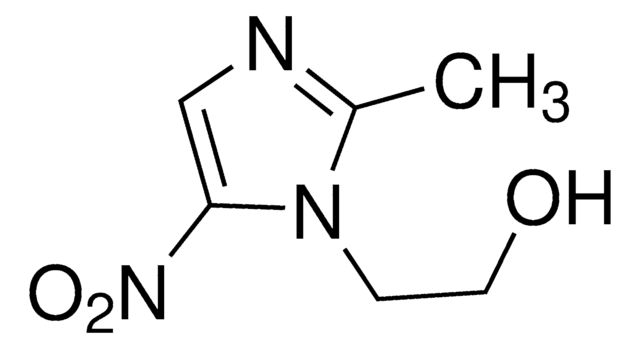1458009
USP
Neomycin sulfate
United States Pharmacopeia (USP) Reference Standard
Synonym(s):
Neomycin trisulfate salt, Neomycin B sulfate
About This Item
Recommended Products
grade
pharmaceutical primary standard
API family
neomycin
manufacturer/tradename
USP
application(s)
pharmaceutical (small molecule)
format
neat
InChI
1S/C23H46N6O13.H2O4S/c24-2-7-13(32)15(34)10(28)21(37-7)40-18-6(27)1-5(26)12(31)20(18)42-23-17(36)19(9(4-30)39-23)41-22-11(29)16(35)14(33)8(3-25)38-22;1-5(2,3)4/h5-23,30-36H,1-4,24-29H2;(H2,1,2,3,4)/t5-,6+,7-,8+,9-,10-,11-,12+,13-,14-,15-,16-,17-,18-,19-,20-,21-,22?,23+;/m1./s1
InChI key
OIXVKQDWLFHVGR-GQTDVWSESA-N
General description
Neomycin sulfate USP reference standard is provided as delivered and specified by the issuing Pharmacopoeia. All information provided in support of this product, including MSDS and any product information leaflets, has been developed and issued under the Authority of the issuing Pharmacopoeia. For further information and support please go to the website of the issuing Pharmacopoeia.
Application
- Neomycin Sulfate Tablets
- Neomycin Sulfate Cream
- Neomycin Sulfate Ointment
- Neomycin Sulfate Ophthalmic Ointment
- Neomycin Sulfate Oral Solution
- Neomycin Sulfate and Hydrocortisone Cream
Caution
Preparation Note
Other Notes
Legal Information
related product
Signal Word
Danger
Hazard Statements
Precautionary Statements
Hazard Classifications
Resp. Sens. 1 - Skin Sens. 1
Storage Class Code
11 - Combustible Solids
WGK
WGK 3
Flash Point(F)
Not applicable
Flash Point(C)
Not applicable
Certificates of Analysis (COA)
Search for Certificates of Analysis (COA) by entering the products Lot/Batch Number. Lot and Batch Numbers can be found on a product’s label following the words ‘Lot’ or ‘Batch’.
Already Own This Product?
Find documentation for the products that you have recently purchased in the Document Library.
Customers Also Viewed
Our team of scientists has experience in all areas of research including Life Science, Material Science, Chemical Synthesis, Chromatography, Analytical and many others.
Contact Technical Service





